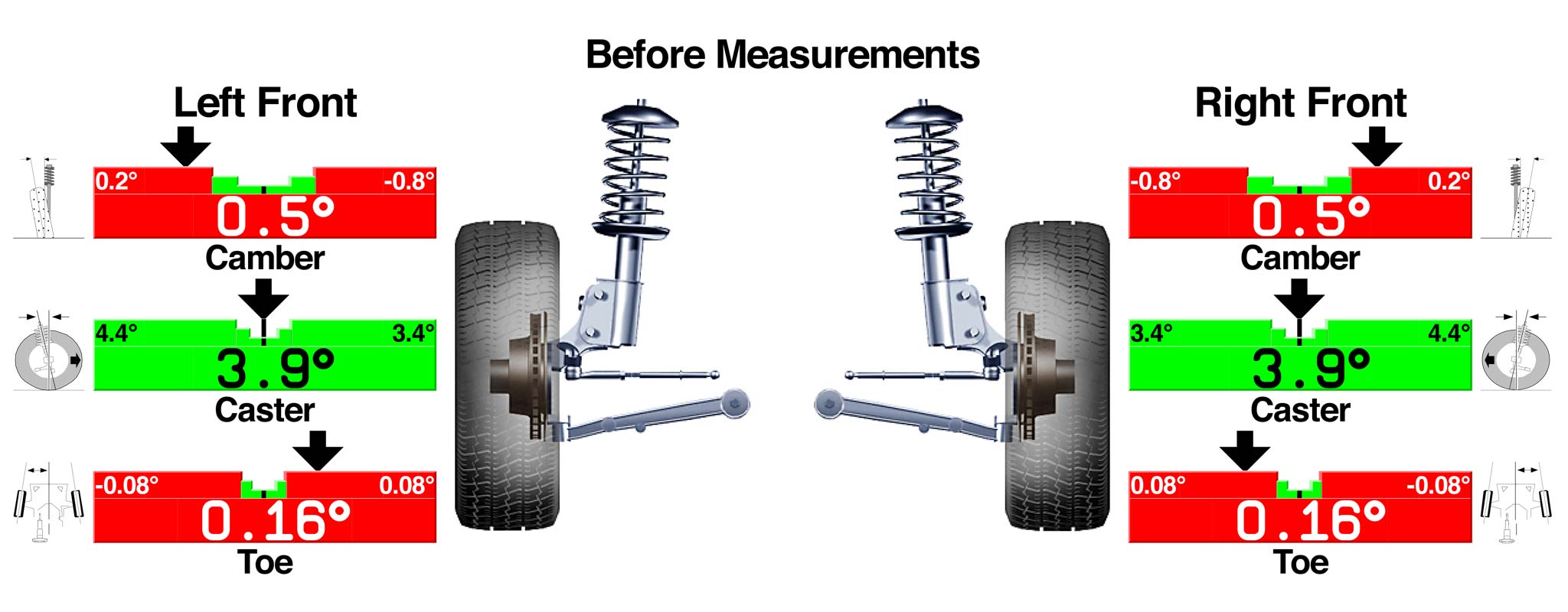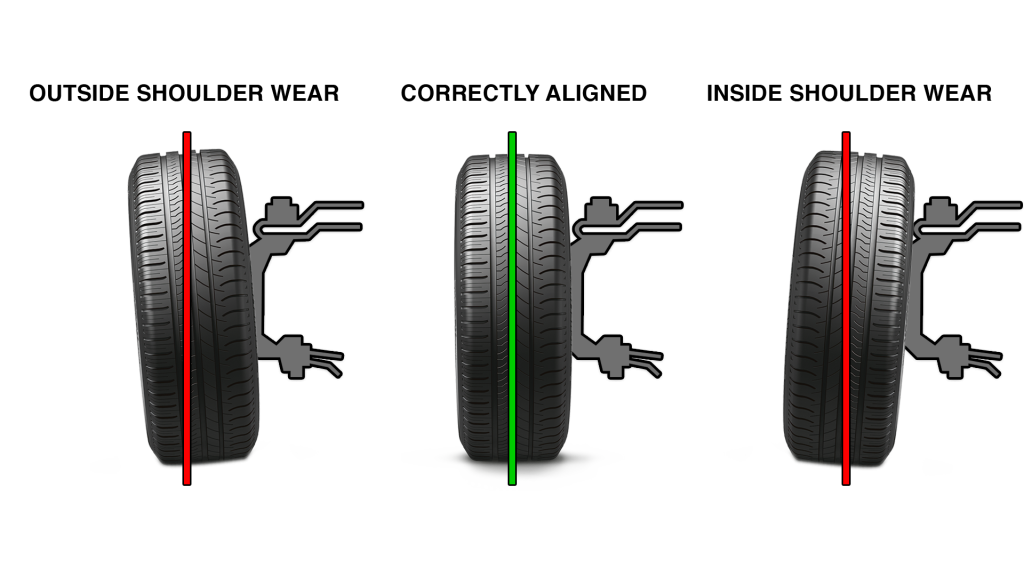Proper wheel alignment ensures your car drives straight and true. It extends tire life and improves handling.
Imagine hitting the road with confidence, knowing your car performs at its best. That’s the assurance proper wheel alignment offers. It’s a critical aspect of vehicle maintenance that many overlook. Aligning your wheels means adjusting the angles of your tires so they make optimal contact with the road.
This might seem like a job for professionals, but with the right tools and a bit of know-how, you can tackle this task. This guide will steer you through the necessary steps to align your wheels, ensuring a smoother ride and safer travels. Whether you’re a car enthusiast or just trying to save a trip to the mechanic, learning how to do wheel alignment is a useful skill that pays off in the long run.

Credit: www.lesschwab.com
Introduction To Wheel Alignment
Wheel alignment is crucial for a smooth ride. It ensures tires wear evenly and your car drives straight. Neglecting it leads to problems. Get to know the importance, signs, and how to align wheels right here.
Importance Of Proper Alignment
Proper wheel alignment extends tire life. It boosts fuel efficiency. Your ride becomes safer. A well-aligned car handles better. It’s key for optimal driving performance.
Signs Your Vehicle Needs An Alignment
- Car pulling to one side
- Uneven tire wear
- Steering wheel off-center
- Handling feels loose

Credit: www.youtube.com
Tools And Equipment Needed
Getting your car’s wheels aligned is important. You need the right tools and equipment. Let’s dive into what you will need.
Essential Alignment Tools
For a successful wheel alignment, gather these items:
- Alignment machine – Measures angles.
- Jack stands – Lifts and holds the car.
- Turn plates – Allows wheels to move during adjustment.
- Steering wheel holder – Keeps the steering wheel straight.
- Camber/caster gauge – Checks the wheel tilt.
Safety Gear And Precautions
Stay safe while working. Use these:
- Safety glasses – Protects your eyes.
- Gloves – Keeps hands safe from dirt and injuries.
- Steel-toe boots – Protects your feet.
Always follow these safety tips:
- Read the manual of the alignment machine.
- Check the car is secure on jack stands.
- Keep your workspace clean.
Pre-alignment Preparation
Wheel alignment is a key part of car maintenance. It keeps your ride smooth and tires in shape. Before getting started, proper preparation is crucial. This ensures a precise and efficient alignment process.
Vehicle Positioning
Start with placing the car on a flat surface. Make sure the vehicle is in a neutral position. This is critical for an accurate alignment. The wheels should point straight ahead. Clear the area around the tires. This gives full access for adjustments.
Initial Inspection
Check the tires for wear and tear. Look for signs of uneven tread wear. This could hint at existing alignment issues. Examine the tire pressure too. Correct tire pressure is essential for a true alignment. Inspect the suspension system as well. Make sure there are no worn out components. Worn parts can throw off the alignment results.
Measuring Current Alignment
Before making any adjustments, it’s essential to measure your car’s current alignment. This process checks the angle and direction of the wheels. Let’s dive into the specifics of assessing toe, camber, and caster.
Assessing Toe, Camber, And Caster
Three key factors determine wheel stability: toe, camber, and caster. The toe refers to the angle of the wheels in relation to the vehicle’s centerline. Proper toe alignment ensures your tires move parallel to each other. Camber is the wheel’s tilt, either inward or outward, when viewed from the front. Lastly, caster is the angle of the steering axis when viewed from the side of the vehicle. It affects balance, cornering, and stability.
Interpreting Alignment Readings
Understanding the alignment readings is crucial for adjustments. Each reading signifies a specific issue with handling or tire wear. For instance, a negative camber might cause the vehicle to pull to one side. Positive caster helps with stability at high speeds. Knowing these details aids in making accurate corrections.
Adjusting Toe Alignment
Adjusting Toe Alignment is key for smooth driving. It affects how straight your car travels. Think of it as how your feet point. Straight ahead? Or do they point in or out? That’s what toe alignment is about. Let’s make it right.
Adjusting Front Toe
Front toe keeps your car stable at high speeds. Here’s how to adjust it:
- Loosen the nuts on the tie rods. These rods connect wheels to steering.
- Use a toe alignment tool. It measures angle.
- Adjust tie rods. Turn them until the tool shows correct angle.
- Tighten the nuts back. This locks the angle.
- Check again. Make sure both wheels point straight.
Tools needed: Wrench, toe alignment tool.
Adjusting Rear Toe
Rear toe keeps your car from weaving side to side. Here’s how to fix it:
- Find the adjustment bolts. They are near the rear wheels.
- Loosen these bolts slightly.
- Adjust the angle. Like the front, use a tool to check.
- Tighten the bolts. This secures the adjustment.
- Double-check the angle. It must be even on both sides.
Tools needed: Socket set, rear toe alignment tool.
Adjusting Camber And Caster
Adjusting camber and caster is key to perfect wheel alignment. It affects steering, stability, and tire wear. Let’s dive into the camber adjustment process and caster angle tuning.
Camber Adjustment Process
Camber refers to the wheel’s tilt, either inward or outward. Correct camber ensures flat tire contact with the road. Here’s how to adjust it:
- Locate the camber bolts on the wheel assembly.
- Loosen these bolts slightly.
- Adjust the wheel tilt to desired camber settings.
- Tighten the bolts to secure the adjustment.
- Verify the camber with an alignment tool.
Caster Angle Tuning
Caster angle affects steering feel and straight-line stability. Proper caster angle makes a car easy to handle. Follow these steps:
- Position the car on an alignment rack.
- Measure current caster angles with a gauge.
- Access the strut mount or control arm.
- Adjust the caster to the manufacturer’s specification.
- Re-check measurements to ensure accuracy.
Always double-check both camber and caster settings. Aim for precision to avoid uneven tire wear and handling issues. Aligning these angles enhances driving comfort and safety.
Test Drive And Re-evaluation
Wheel alignment is crucial for safe driving. After adjustments, a test drive and re-evaluation confirm proper alignment. This step ensures your vehicle handles correctly and the tires wear evenly. Let’s explore how to execute a thorough post-alignment assessment.
Conducting A Post-alignment Test Drive
Once your vehicle’s wheels are aligned, a test drive is essential. This drive checks the alignment’s effectiveness. Look for the following:
- Straight steering: The car should drive straight without pulling to a side.
- Wheel position: When driving straight, the steering wheel should be centered.
- Handling: The vehicle should handle smoothly around corners.
- Noises: Listen for unusual sounds that may indicate issues.
Note any concerns. They might need more adjustments.
Re-measuring And Fine-tuning
If the test drive indicates problems, re-measure the alignment. Use precision tools to check wheel angles:
- Camber: The tilt of the tire inward or outward.
- Toe: The direction the tires point relative to each other.
- Caster: The angle of the steering axis.
Adjust as needed for optimal performance. Repeat the process until the vehicle drives perfectly. Keep records of the settings for future reference.

Credit: www.royalhonda.com
Maintaining Wheel Alignment
Maintaining wheel alignment is key for a smooth ride. It saves tires from wearing out fast. It also keeps the car running straight. This guide will show you how to keep your wheels aligned.
Regular Checks And Balancing
Check wheel alignment often. Every six months or 6,000 miles is good. This helps catch issues early. A balanced car feels better to drive. It also uses less fuel. Use a trusted mechanic for checks. They have the right tools.
Tips For Prolonging Alignment
Drive carefully. Avoid potholes and rough roads. These can mess up alignment. Carry the right amount of load. Too much weight hurts the wheels. Regular tire checks help too. Keep them inflated right. This prevents uneven wear.
Common Mistakes To Avoid
Let’s talk about wheel alignment. A straight drive keeps your car happy. But aligning wheels is tricky. Small mistakes can cause big issues. Here are common errors to dodge for a smooth ride.
Misreading Alignment Specifications
Getting specs right is key. Each car has its own alignment needs. Here’s what to avoid:
- Wrong specs: Always double-check your car’s specs. Use reliable sources.
- Guesswork: Don’t guess angles. Use precise tools.
- Outdated info: Car models change. Always use the latest data.
Ignoring Vehicle-specific Procedures
Each car has a unique build. It means special alignment steps. Always follow these:
- Manufacturer guides: These are your best friends. Read them well.
- Special tools: Some cars need unique tools. Make sure you have them.
- Reset systems: Modern cars have sensors. Reset them after aligning.
Professional Vs. Diy Alignment
Deciding between professional or DIY wheel alignment is crucial for car maintenance. Each option offers unique advantages. Your choice depends on skill level, tools available, and confidence.
When To Seek Professional Help
Professional help is vital when signs of misalignment appear. These include uneven tire wear, steering wheel vibration, and the car pulling to one side. Mechanics have precise tools and expertise. They ensure your car’s alignment meets manufacturer specifications. This guarantees safety and optimal performance.
Benefits Of Learning Diy Alignment
DIY alignment teaches valuable skills and saves money. With basic tools and patience, you can manage minor adjustments at home. It’s a useful skill for regular maintenance. This can extend the life of your tires and improve driving comfort.
Frequently Asked Questions
What Is Wheel Alignment?
Wheel alignment is the process of adjusting the angles of wheels to the car manufacturer’s specifications. This ensures that the vehicle’s wheels are perpendicular to the ground and parallel to each other, improving tire performance and lifespan.
Why Is Proper Wheel Alignment Important?
Proper wheel alignment is crucial for even tire wear, optimal gas mileage, and safe, predictable vehicle handling. It also helps prevent strain on the car’s suspension components, ensuring a smoother ride.
How Often Should Wheel Alignment Be Done?
Wheel alignment should generally be checked every 6,000 miles or 6 months, whichever comes first. It’s also wise to get an alignment after getting new tires, or if you notice uneven tire wear or steering issues.
Can I Do Wheel Alignment At Home?
While it’s possible to do a basic wheel alignment at home with the right tools and knowledge, professional equipment is needed for precise adjustments. Most people prefer visiting a mechanic to ensure accuracy.
Conclusion
Wheel alignment is crucial for a smooth ride. It extends tire life and improves fuel efficiency. Regular checks prevent future car issues. This guide showed easy steps to align wheels. Always prioritize safety and use the right tools. Practice makes perfect.
Over time, you’ll get better at this important maintenance task. Remember, a well-aligned car performs better. So, take the time to check your alignment. Your car will thank you—and so will your wallet. Drive safe and enjoy the ride!